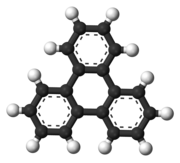This is an old revision of this page, as edited by Lamro (talk | contribs) at 11:14, 14 October 2011 (link). The present address (URL) is a permanent link to this revision, which may differ significantly from the current revision.
Revision as of 11:14, 14 October 2011 by Lamro (talk | contribs) (link)(diff) ← Previous revision | Latest revision (diff) | Newer revision → (diff)
| |

| |
| Names | |
|---|---|
| IUPAC name triphenylene | |
| Other names benzophenanthrene, 9,10-benzophenanthrene, 1,2,3,4-dibenznaphthalene, isochrysene | |
| Identifiers | |
| CAS Number | |
| 3D model (JSmol) | |
| ECHA InfoCard | 100.005.385 |
| KEGG | |
| CompTox Dashboard (EPA) | |
InChI
| |
SMILES
| |
| Properties | |
| Chemical formula | C18H12 |
| Molar mass | 228.294 g·mol |
| Melting point | 198 °C; 388 °F; 471 K |
| Boiling point | 438 °C; 820 °F; 711 K |
| Except where otherwise noted, data are given for materials in their standard state (at 25 °C , 100 kPa).
| |
In chemistry, the organic compound triphenylene is a flat polycyclic aromatic hydrocarbon (PAH) consisting of four fused benzene rings. Triphenylene can be isolated from coal tar, but it is also made synthetically using benzyn chemistry. One molecule of triphenylene has delocalized 18-π-electron systems based on a planar structure. It has the molecular formula C
18H
12.
Triphenylene is a fully benzenoid PAH, meaning its structure is composed only of full benzene rings interconnected by carbon-carbon single bonds. The three benzene rings can be drawn as the three outer rings, with the central ring formed by one face of each and the three carbon-carbon single bonds.
Being a fully bezenoid PAH means that triphenylene is much more resonance stable than its isomers chrysene, benzanthracene, benzophenanthrene, and tetracene. This makes it much more difficult to hydrogenate to the saturated hydrocarbon.
In light of these characteristics, triphenylene may have uses in optics and electronics. Triphenylene is a disc-shaped molecule with a planar structure and three-fold rotation axes. Consisting of colorless needle-like crystals, it emits bluish purple fluorescence by UV irradiation.
In terms of its crystallographic point group, the symmetry of triphenylene is classified as D3h in Schoenflies notation. Because of these characteristics, six-fold (in the 2, 3, 6, 7, 10, and 11 positions) alkyloxy- or alkylthiol-substituted triphenylenes can be used as a discotic mesogen in liquid crystalline materials.
References
- Polycyclic Aromatic Hydrocarbon Structure Index
- Synthesis: Organic Syntheses, Coll. Vol. 5, p.1120 (1973); Vol. 40, p.105 (1960).
| Polycyclic aromatic hydrocarbons | |
|---|---|
| 2 rings | |
| 3 rings | |
| 4 rings | |
| 5 rings | |
| 6 rings | |
| 7+ rings | |
| General classes | |